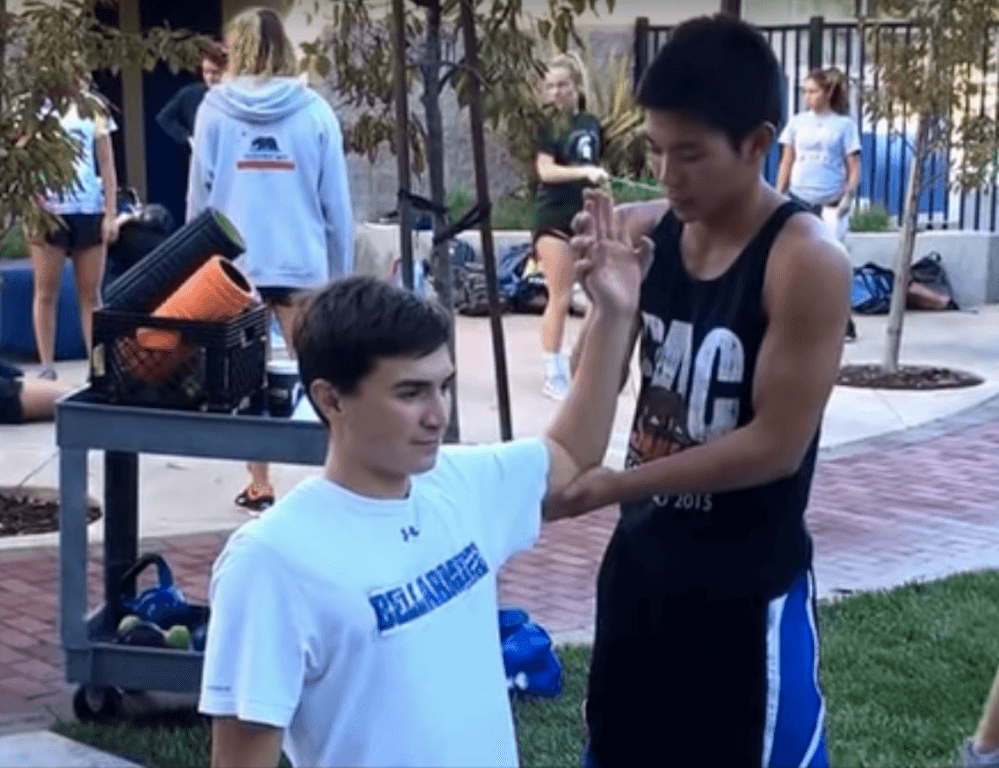2 Missing Parts of Your Swimmers’ Shoulder Injury Prevention Program

By Dr. G. John Mullen, Swimming World Contributor
I often discuss shoulder health, in fact many of you are probably sick of me laboring about shoulder injuries and injury prevention. Unfortunately, I feel like I’m not getting my point across, as thousands of swimmers enter our clinic each year with shoulder pain and injury (remember why you shouldn’t shrug off swimmer’s shoulder). This is because teams still aren’t implementing the mandatory components of a swimmers shoulder prevention program!
Recently, a great research study by Matthews (2016) looked at the effects of 8 × 100 m training swims off a 2:00 interval. Target times were prescribed for each swimmer based on 85 percent of their best 100-meter times. This study suggested one set of 8 x 100 m caused the following:
- Impaired shoulder proprioception (joint sense of position)
- Reduced shoulder external rotation range of motion
Simply performing one 16-minute set greatly altered shoulder characteristics!
Imagine what happens to the shoulder after a whole practice, a week of winter training, or even a swimming season!
These reasons make systematic strength training and injury prevention programs key for long-term health of the shoulder. Matthews (2016) provided excellent recommendations at the end of their article:
“These results, along with the clear link between training volume and impingement injuries (Beach et al., 1992, Lynch et al., 2010 and Walker et al., 2012), leads us to question the wisdom of adolescents swimming the high volumes reported (Allegrucci et al., 1995, Lynch et al., 2010 and Sein et al., 2010), without first having an injury prevention and strengthening programme focused on the functional eccentric strength of the external stabilising muscles of the shoulder. In each concentric ‘power stroke’ the small stabilising muscles must work synergistically to prevent the anterior translation of the humeral head. Continued fatigue and poor joint position sense could result in anterior humeral head translation due to the dominance of overactive pectoral minor and latisimus dorsi muscles leading to laxity of the weaker posterior muscles (Tate et al., 2012). Anterior translation places the shoulder in a position whereby the subacromial space is compressed, potentially aggravating tissues such as the subacromial bursa and supraspinatus, leading to the impingement syndrome known as ‘swimmers shoulder’. Anterior translation will also cause an internal rotation of the humerus putting additional strain on the long head of biceps tendon.
Given the significant reduction in external rotation range and increased proprioceptive variance as a result of fatigue, along with the significant correlation observed between stroke length and strength, it is possible that competitive swimmers may benefit from a shoulder external rotation strengthening programme that includes inner range external rotation activities, mobility training aimed at restoring external rotation range of motion, and proprioception training. It is possible that such a programme could help swimmers maintain stroke length and external rotation range after fatiguing swimming. This may be relevant to injury prevention because it may help swimmers offset the pull from the dominant internal rotators and reduce potential for impingement of supraspinatus tendon (Kluemper et al., 2006).”
Michael Vaandering, strength coach at COR, wrote a great piece differentiating the different types of impingement of the shoulder [Internal and External Shoulder Impingements: What You Need To Know].
I’ve discussed numerous methods to restore mobility and have broken it down in great detail in Mobility for Swimmers. However, eccentric posterior rotator cuff training and proprioception training I haven’t discussed as much [well, I did write this article a few years back Forgotten Aspect of Swimmers Shoulder Prevention/Rehabilitation: Motor Control Training!].
Two Missing Parts of Your Swimmers’ Shoulder Prevention Program
1. Eccentric Shoulder Strengthening
2. Shoulder Proprioception Training
For more information, checkout the Advanced Swimming Podcast, “Shoulder Pain: Strengthening, Flexibility, or Something Else?”
Reference:
- Matthews MJ, Green D, Matthews H, Swanwick E. The effects of swimming fatigue on shoulder strength, range of motion, joint control, and performance in swimmers.Phys Ther Sport. 2016 Aug 30. pii: S1466-853X(16)30090-6. doi: 10.1016/j.ptsp.2016.08.011. [Epub ahead of print]




Ana Filipa Chaby Lobo
Luke Shepherd
This picture of two students assisting in shoulder range of motion exercises exhibits a potentially dangerous and important aspect of the shoulder range of motion where if the external rotation is done at the shoulder, the thumb must be facing back and the palm of the hand of the exercised arm must be not (!) facing the front but but instead be supinated to clear the acromion process in the humerus or this particular picture that is presented here will cause shoulder impingement and the irritation/inflammation of the affected shoulder. Whoever educated these athletes, must ensure that the acromion process is cleared or these range of motion activities will cause more damage than good.
Lizzy Lu
Gleneen Kozlowski Orndahl
Helena Blumenau
Amanda Wike
Kyle Ruiz
Brittany Archer
Jana Hemdan
Lana Hemdan
Nick Whitcomb
Can you do one on breaststroke knees?!?
Kaleb Hatch
Trent Cuzens
Clarissa Brito
Gordon Highmore